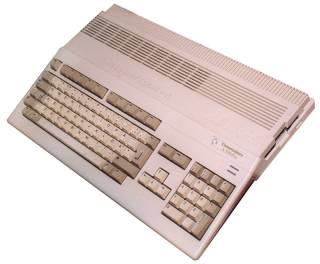Amiga last edited by AstraEX on 01/07/19 04:00AM View full history
Overview and History
The Commodore Amiga are a series of computers released during the span of 1985 until 1994, primarily created by the company Commodore Business Machines, Inc.
The design team was headed up by Jay Miner and development of the system began in 1982 under the Amiga Corporation company. Commodore acquired Amiga Corporation in the summer of 1984, snatching the Amiga chipset from under the nose of Atari, who originally funded the project. Commodore filed for bankruptcy in 1994, despite the success of the A1200 and CD32. In 1997, Jeff Schindler founded Amiga, Inc. in South Dakota, which was a subsidiary of Gateway, Inc. which bought the Interlectual Property of Amiga from Escom AG during the same year.
Later in 1999, Gateway, Inc. sold the brand to Bill McEwen and is since then running Amiga, Inc. as a Public company.
Nowadays, Computers running on the Amiga brand are run by the PowerPC architecture and run via the AmigaOS 4 Operating System that is maintained by third party companies.
Hardware
The Amiga range was based on the Motorola 68000 chipset, but made use of proprietary graphics and sound co-processors (codenamed Denise and Paula respectively), which took the load off of the CPU and allowed the Amiga to process more than just gaming graphics extremely efficiently. The Amiga revolutionized video production, providing an affordable CG solution with the Newtek Video Toaster (which later evolved into the Newtek TriCaster, the core of Giant Bomb's video production). It was the first consumer grade computer to be able to sample and record stereo audio in 44.1khz (CD quality) at the time. Over the lifetime of the computer, three graphics and sound chipsets were used: OCS (Original ChipSet), ECS (Enhanced ChipSet) and AGA (Advanced Graphics Architecture).
Classic Amiga Models
| Released | Model | Codename | Chipset | Memory | Kickstarter | Variants | Colours |
|---|---|---|---|---|---|---|---|
July 23 1985 | Amiga 1000 | Lorraine | OCS | 256k onboard, upgradable to 512k | v1.0 - v1.3, on floppy disc | 32 on screen, 4096 palette | |
March 1987 | Amiga 2000 | The Boss | OCS | 1MB onboard, upgradable to 8MB | v1.3 or v2.0, in ROM | A1500 - UK only, second floppy instead of hard drive A2000C - ECS variant A2500 - Pro variant with 68030 CPU "accelerator" | 64 on screen, 4096 palette |
October 1987 | Amiga 500 | Rock Lobster | OCS | 512k onboard, upgradable to 1MB | v1.2 or v1.3, in ROM | A500+ - ECS, v2.04, 1MB RAM CDTV - Hi-fi case and CD-ROM, based on A500+ | 64 on screen, 4096 palette |
June 1990 | Amiga 3000 | B2 | ECS | 2MB onboard, upgradable to 16MB | v1.3 or v2.0, in ROM | A3000UX - bundled with Unix A3000T - tower variant | 256 on screen, 4096 palette |
March 1992 | Amiga 600 | Junebug | ECS | 1MB onboard, upgradable to 2MB | v2.05, in ROM | A600HD - included 20MB or 40MB hard drive | 64 on screen, 4096 palette |
September 1992 | Amiga 4000 | Pandora | AGA | 2MB onboard, upgradable to 16MB | v3.0, in ROM | A4000T - Tower case, 68040 CPU | 4096 on screen, 262,144 palette |
October 1992 | Amiga 1200 | Channel Z | AGA | 2MB onboard, upgradable to 8MB | v3.0, in ROM | CD32 - Console variant. CD-ROM, no keyboard, no floppy disk drive, no upgradable RAM (codename "Spellbound") | 4096 on screen, 262,144 palette |
Operating System
AmigaOS
The AmigaOS originally was split into two parts, the Kickstarter and the Workbench.
The Amiga 1000 required a Kickstarter disc to boot before any other disc could be loaded. The benefits of this were easy OS upgrades (v1.0-1.3), however it also provided an easy vector for the first Amiga viruses to spread. The Amiga 500 onwards stored the Kickstarter (v1.2+) in ROM, thereby eliminating the need for an initial disc boot.
The Workbench was an optional windowing system and file manager, similar to Mac OS or Windows. Unlike those systems, games could launch at boot instead of the Workbench in order to give them larger access to system resources.
At later date, systems running on the Amiga brand are running on user maintained Operating Systems such as AmigaOS 4, which is the evolution of the official Workbench version 3.1 before Commodore Business Machines, inc shut down.
The open source continuitation of the Amiga OS is called AROS Research Operating System and is in active development since 1995.


Log in to comment